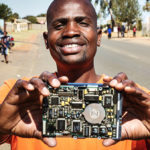At Cisco, we are committed to accelerating the transition of our business to the circular economy. We aim for all of our resources to follow a circular model – where we reduce our consumption of natural resources and design waste out of our value cycle, enabling products and packaging to be used and reused longer. This work goes beyond a series of projects or initiatives that eventually end with people shifting to work on new topics.
To achieve circularity and truly impact our planet, we are synthesizing our circular economy objectives with the way we run our business. We are aligned as a company to achieve new ambitions towards sustainable packaging and zero-waste manufacturing that are captured in the following new goals.
By FY2025, Cisco is committing:
- To reduce our foam packaging use by 75%, as measured by weight (FY2019 base year)
- To improve product packaging efficiency by 50%, as measured by package volume per weight of product (FY2019 base year)
- That 70% of Cisco’s manufacturing suppliers by spend will achieve a “zero waste” diversion rate* at one or more site(s)
In a circular economy, there is no such thing as waste. However, many packaging materials become waste immediately after first use which means they need to be easy to recycle or completely eliminated. Some common materials used for packaging are difficult to recycle, like foams or expanded polymers, yet they continue to be selected due to the ability to prevent damage to products during shipment with strong cushioning. Many municipal recycling programs do not accept foams because it is cost-prohibitive and logistically challenging to collect and recycle. For plastic packaging more broadly, only 14% of the plastic packaging used globally is recycled (World Economic Forum, The New Plastics Economy).
While protective packaging is essential to safely transport our products to our partners and customers, we are changing how we design our packaging and select materials to reduce our collective environmental footprint and meet our customers demands for sustainable packaging. Our new packaging goals focus on foams and packaging efficiency – two key levers we can push to improve recyclability, reduce material use, and reduce the emissions and costs associated with the packaging and transportation of our products.
We know that waste exists beyond our product packaging, therefore, we are also looking at opportunities to reduce manufacturing waste related to making our hardware. Zero Waste projects facilitate decreased costs, increased revenue, and reduced risk for our suppliers. These outcomes are achieved through improved resource efficiency, such as the reuse of materials, material and process optimization, and the use or sale of byproducts to become material inputs for other products. By setting a zero waste goal, we hope to accelerate advancement across our supply chain for how reusable materials are managed, sourced, and valued. Our vision is to change the conversation from one about “waste” to one about valuable resources.
Cisco’s new goals supplement our existing circular design goals to reduce our use of virgin plastic by 20% by 2025 and to design all new products using circular design principles by 2025. The mechanical design of our products plays a crucial role in the packaging required and potentially in the manufacturing waste associated with production. By approaching our goals holistically, and considering the full lifecycle of our products and packaging, we can optimize our products, packaging, and transportation simultaneously and sustainably. We will achieve significant reductions in greenhouse gas emissions and waste by reducing unnecessary material use.
The circular economy model is only as strong as the sum of its parts. There is tremendous opportunity for everyone to participate as we move to a circular economy. We hope you will join us in building a more sustainable future.
For more information on Cisco’s approach to environmental sustainability, please read our Corporate Social Responsibility Report.
*According to current standard definitions used in certification protocols, “zero waste” diversion is defined as a 90% or greater overall diversion of solid, non-hazardous wastes from landfill, incineration (waste-to-energy), and the environment. Diversion methods can include reduction, reuse, recycling, and/or compost.


Thank you Cisco! This is a bold move, and it will take some time, effort and pain. It's a challenge and I'm so proud to be a part of this company for decisions like these, way to go!
Start the SFPs! There's more trash than product in each box.
@ChrisK, You're comment is completely on point ! We've been working with TMGBU to look into alternative options, such as reusable packaging and other packaging efficiency options! You can contact circularecoomy@cisco.com for more details!
Congratulations and well done! I am very excited to see these new innovative goals and the transformation that will come in the industry as a result.
I never understood the plastic bags with switch accessoires packed inside a plastic bag, packed inside a plastic bag… at least 1 can be skipped. https://twitter.com/brucefal06/status/1047077548168024064
Hi, quick question is – how does Cisco supplement the circular sustainability model?
Use minimal to none at all (recycling helps, of course!)
@Anonymous
Thank you for the packaging feedback. We are looking into how we can eliminate/reduce unnecessary plastic bags in our accessory kits. Stay tuned for more updates!
@Eli, Cisco is focused on accelerating the adoption of circularity. Our holistic approach extends from how we design, build, and deliver products, to how we value the assets we have and turn them into new products. We also apply Cisco technology to support our customers in their own circular transformations. You can learn more at http://bit.ly/33bJEdz.